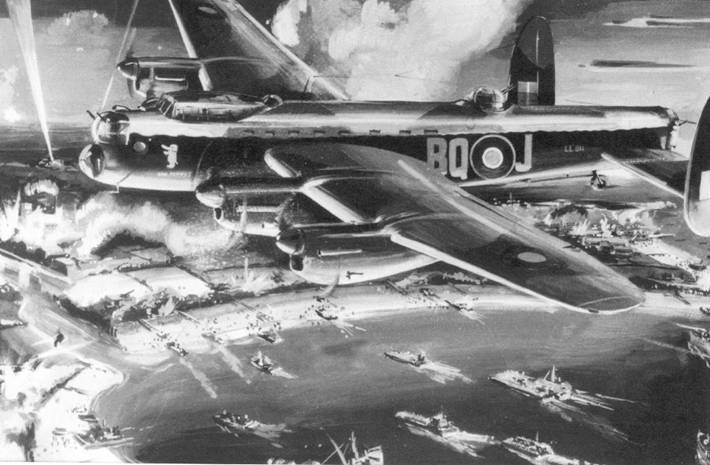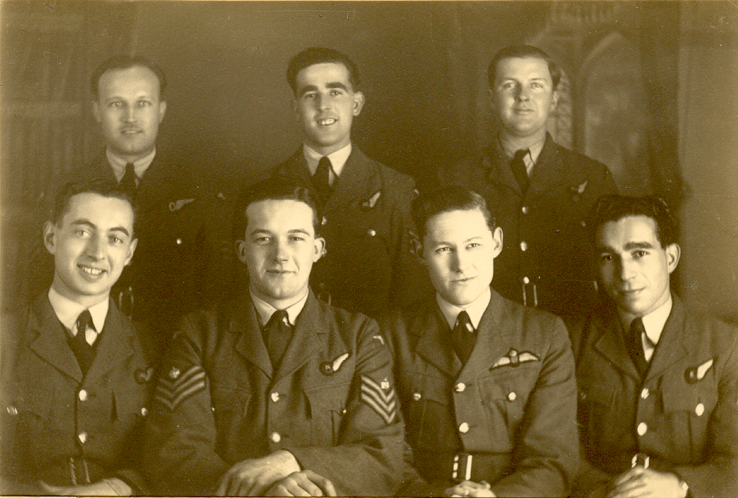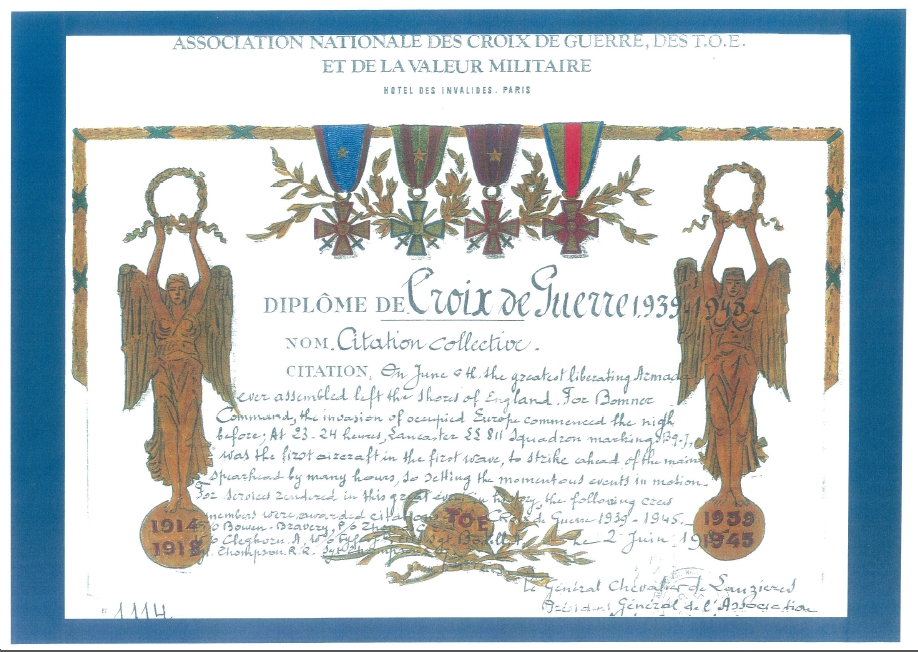|
I wonder what occupied the thoughts of nineteen year old Bert Thomson as he strapped himself into position as the ‘Rear Gunner’ in Lancaster Bomber LL 118 BQJ aka “Bad Penny II” on the night of 5th June 1944? 550 Squadron had been give their orders, for what at the outset seemed a relatively routine trip, the target was a gun battery on the Clifftops at Arromanches on the Normandy coastline. They were armed with 14 x 1,000lb bombs. It took just under 2 hours to reach their target destination and drop to 8,000ft, the height at which the pathfinders markings for the gun emplacements would have been visible. However in the words of Navigator ‘Ward Thomas: “When we got there we couldn’t find it, it was dark. It wasn’t until they made the mistake of shooting at us that we could see them….” Although they were ahead of schedule, pilot Flying Officer Kenyon Bowen-Bravery resolved to drop the bombs anyway. Unbeknown to the young crew that decision was to earn them a place in the history books. Bombs despatched at 11.24pm the plane had turned and was heading for home when the most extraordinary sight became visible in the bright moonlight. The sea was simply covered in boats, hundreds and hundreds of them as far as the eye could see. The enormity of what was about to happen hit home -D-Day had arrived! The “Bad Penny II” and her crew made it safely back to base at 1.18am to the news they had dropped the opening salvo of bombs to start ‘Operation Overlord’, later heralded, “a triumph of deception, secrecy and logistics” and “The greatest liberating armada in military history”. That night, 1,012 aircraft - 551 Lancasters, 412 Halifaxes and 49 Mosquitos - followed ‘Bad Penny II’ into D-Day. The crew of J for Jig “The Bad Penny II” at the time of their famous D-Day raid were:
They were collectively awarded the Croix de Guerre by the French Government, although the Citation listed every one of the crew individually as being honoured for ‘services rendered in this great event in history’. This rankled the Flight Engineer Len Thompson who began a lengthy campaign with the French Government to no avail. In 1995 a Belgian lady acquired a brass copy from a specialist medal shop in France. Len was delighted but felt sorry for the rest of the crew and set about acquiring copies for all of them, with the exception of J P Fyffe, (ironically the bomb aimer) with whom they had lost contact and could find no trace. Bert, who flew a total of 32 bombing raids in a Lancaster and a further 16 in an American Mitchell, finally received his medal in appreciation of the actiontaken that famous that night in 1944, through the post in the summer of 1996 - in excess of 50 years later! Bert was baptised 'Robert Redpath Thomson' at Eckford in 1924 and in 1944 he married his childhood sweetheart Elspeth Bell Brown. Post war he returned to his job as rabbit catcher, before later becoming a lorry driver. Throughout his life Bert was well known for his cheerful disposition and ‘can do’ attitude. He passed away on 25th November 2000 aged 76. There are two points that strike me about Bert that have not been mentioned anywhere to date:
Firstly as a Rear Gunner he would never have seen where the plane was going, only where it had been!. Secondly and more importantly, every record I can find relating to Bert, even the C de G award certificate itself has misspelt his name! It was Thomson without a ‘P’! It would be nice to think someone, somewhere could rectify this problem with a note to the records so future generations wishing to read about his exploits that night can actually find him! LINKS You can find much more information and pictures relating to 550 Squadron here: http://www.550squadronassociation.org.uk/
4 Comments
5/6/2015 08:46:52 am
I found this very interesting as although I come from Berwick I have Scottish ancestry. Do you know where the other crew members came from, in particular Sgt.Cleghorn. Thank you
Reply
Elaine
27/2/2024 07:43:37 pm
Hi, i’m Alex Cleghorn’s daughter and, although I believe he had Scottish ancestry, he was born and grew up in Stoke Newington, London. He joined the RAF underage and, after completing his ops, he returned home to set up his own woodworking business, which later became a very successful melamine company. He moved to Chingford and later, to Wickham Bishops in Essex. He married Winnie and had three children. The eldest, Barry, passed away as a baby. Then followed my brother, Glenn and me. My dad had a very happy life, but didn’t talk much about the war. I think he was racked with guilt because of the civilians who perished as a result of the bombing. He passed away suddenly in 1999, aged 74.
Reply
Colin renwick
26/5/2016 12:35:52 am
Hi as a young lad I was brought up at eastfield of lempitlaw 2 houses up from Bert Thompson and his wife Elsie I become great friends with Bert's grandson David Douglas from kelso .At every opportunity we would go with Bert in the farm lorry to pick up or deliver cattle or what ever other duties that had to be done, Bert didn't talk much about his time in the Lancaster but when he did we would listen in aww to his fascinating tails and very accurate detailed stories and as a kid trying to imagine the scene in your head and your imagination running wild .To this day I still feel very humble and privileged to have known such a great character who put his life on the line for his country .such a brave man ,great friend and neighbour never forgotten .
Reply
David Welsh
13/1/2018 07:41:42 pm
I was born and brought up in Sprouston and walked past Mr Thomson's grave this afternoon. I have often wondered how he got his C de G. Now I know - so thanks for that.
Reply
Leave a Reply. |
AuthorSusie Douglas Archives
December 2021
Categories |
Copyright © 2013 Borders Ancestry
Borders Ancestry is registered with the Information Commissioner's Office No ZA226102 https://ico.org.uk. Read our Privacy Policy



 RSS Feed
RSS Feed

